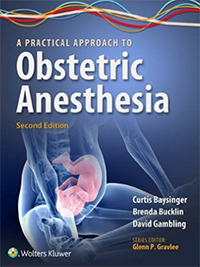
Edition 2 (2016)
Curtis Baysinger, Brenda Bucklin, David Gambling
Successfully combining the comprehensive depth of a textbook and the user-friendly features o fa practical handbook, A Practical Approach to Obstetric Anesthesia, 2nd Edition, is a portable resource for both experienced and novice clinicians. Focusing on clinical issues in obstetric anesthesia, it uses an easy-to-follow outline format for quick reference, enhanced with numerous tables, figures, and photographs. The use of color in this edition highlights key information and improves readability for daily practice and study.
Key Features:
Presents the most up-to-date information available in obstetric anesthesiology, including guidance on both routine and complicated patient care.
Features new chapters on ultrasound and echocardiographic techniques, trauma, management of the opioid dependent parturient, and maternal morbidity and mortality.
Covers pharmacology and physiology, antepartum considerations, labor and delivery, postpartum issues, and disease states in obstetric patients, including a chapter on obesity and pregnancy, as well as guidelines from national organizations.
Provides Clinical Pearls throughout, as well as Key Points in each chapter and current references for further study.
Now with the print edition, enjoy the bundled interactive eBook edition, which can be downloaded to your tablet and smartphone or accessed online and includes features like:
Complete content with enhanced navigation
Powerful search tools and smart navigation cross-links that pull results from content in the book, your notes, and even the web
Cross-linked pages, references, and more for easy navigation
Highlighting tool for easier reference of key content throughout the text
Ability to take and share notes with friends and colleagues
Quick reference tabbing to save your favorite content for future use
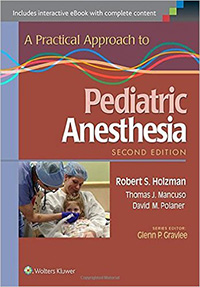
Edition 2 (2015)
Robert Holzman, Thomas Mancuso, David Polaner
Part of the highly popular Practical Approach to Anesthesia series, this new edition combines the comprehensive depth of a textbook and the user-friendly features of a practical handbook. Focusing on clinical issues in pediatric anesthesia, it contains the in-depth information you need for daily practice and study, presented in a concise, bulleted format for quick reference. With its emphasis on developmental aspects of pediatric anesthesia, numerous illustrations and tables, and methodical approach to decision making, this updated reference is an invaluable resource for anyone involved with anesthesia of children.
Key Features
Features new chapters on vascular biology and vascular anomalies, healing and recovery in pediatric surgery, and training and education in pediatric anesthesia. All existing chapters have been fully updated to keep you up to date.
Covers key issues of growth and development – anatomic, physiologic, and pharmacologic – that form the basis for a better understanding of pediatric anesthesia.
Discusses the approach to the pediatric patient, clinical and operational aspects of pediatric anesthesia, anesthetic management of normalities and abnormalities of each organ system, and special situations such as fetal surgery, anesthesia outside the operating room, and trauma.
Provides a clear understanding of anomalies, embryology, anatomy, and surgery so that you’re well prepared to choose the best induction, maintenance, and emergence techniques, as well as make informed monitoring and equipment decisions.
Presents information in a bulleted, outline format for easy reference and review.
Now with the print edition, enjoy the bundled interactive eBook edition, which can be downloaded to your tablet and smartphone or accessed online and includes features like:
Complete content with enhanced navigation
Powerful search tools and smart navigation cross-links that pull results from content in the book, your notes, and even the web
Cross-linked pages, references, and more for easy navigation
Highlighting tool for easier reference of key content throughout the text
Ability to take and share notes with friends and colleagues
Quick reference tabbing to save your favorite content for future use
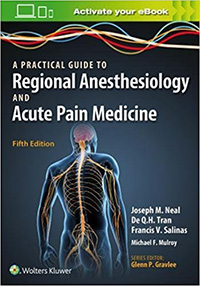
Edition 5 (2017)
Joseph Neal, De Tran, Francis Salina
Apply the latest advances in regional anesthesia and acute pain medicine!
Originally authored by Michael F. Mulroy, MD, this respected title has helped practitioners provide effective regional anesthesia for nearly 30 years. Now it has been retitled A Practical Approach to Regional Anesthesiology and Acute Pain Medicine to reflect the Accreditation Council for Graduate Medical Education’s recent establishment of Regional Anesthesiology and Acute Pain Medicine as an anesthesiology fellowship. This clinical reference has evolved with the many changes in this subspecialty to continue bringing you the up-to-date, clinically focused, hands-on guidance you need to offer your patients the best possible care.
Master the latest advances in the field with expanded coverage of truncal blocks, systems-based practice, acute pain medicine, and much more.
Make optimal use of ultrasound guidance as a nerve localization tool for peripheral nerve blocks, thanks to updated and expanded coverage as well as many new and improved illustrations.
The techniques, approaches, and systems-based practices covered in 5th edition will enhance the application and role of regional anesthesia in Enhanced Recovery After Surgery (ERAS) pathways and the perioperative surgical home. Easily find and apply the answers you need thanks to a highly readable, focused, richly illustrated format that provides balanced discussions of indications, complications, and techniques.
Your book purchase includes a complimentary download of the enhanced eBook for iOS, Android, PC & Mac. Take advantage of these practical features that will improve your eBook experience:
The ability to download the eBook on multiple devices at one time — providing a seamless reading experience online or offline
Powerful search tools and smart navigation cross-links that allow you to search within this book, or across your entire library of VitalSource eBooks
Multiple viewing options that enable you to scale images and text to any size without losing page clarity as well as responsive design
The ability to highlight text and add notes with one click
See the inside front cover to find out how to access your eBook!
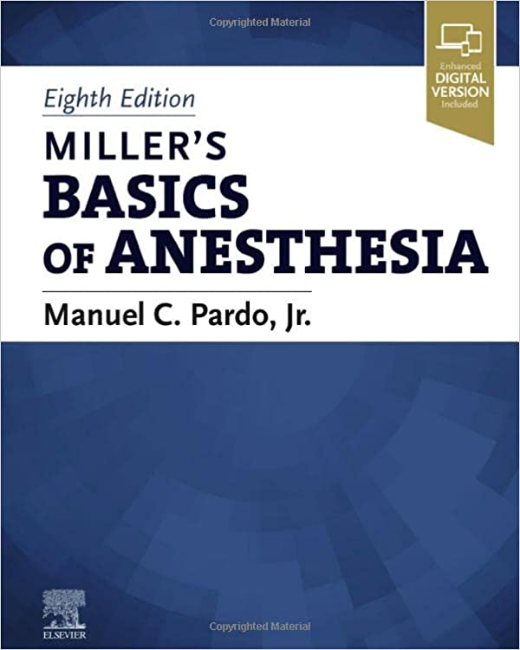
Edition 8 (2022)
Manuel Pardo
Long regarded as the undisputed leading text of its kind, Miller’s Basics of Anesthesia provides comprehensive yet concise coverage of both basic science and clinical topics in anesthesiology. Under the experienced editorial leadership of Dr. Manuel C. Pardo, Jr., the 8th Edition has been meticulously updated to reflect the latest advances in practice and important aspects of contemporary anesthesia care, including pathophysiology, pharmacology, regional anesthesia, anesthetic management, and special problems and patient groups. It remains the first learning resource of choice for anesthesia providers, including anesthesia residents and fellows, medical students, and student registered nurse anesthetists, and is also a valuable review tool for practitioners undergoing maintenance of certification or recertification.
Features a reader-friendly format with color-coded section tabs, easy-to-read chapters, and a concise writing style, along with color patterns in every chapter for quick navigation.
Contains new chapters on Clinician Well-Being, Perioperative Point-of-Care Ultrasound, Environmental Impact of Anesthetics, and Perioperative Medicine.
Covers key topics such as anesthesia neurotoxicity, palliative care, sleep medicine, trauma, and much more.
Includes high-quality images that offer a detailed visual understanding of complex topics, while numerous figures and tables condense material for easier retention and review.
Shares the knowledge and experience of renowned anesthesia expert Dr. Manuel C. Pardo, Jr. and a team of more than 80 global contributing authors.
Serves both as an initial learning resource and a useful tool for solidifying the essential “must know information and reviewing core knowledge for maintenance of certification.
Enhanced eBook version included with purchase. Your enhanced eBook allows you to access all of the text, figures, and references from the book on a variety of devices.
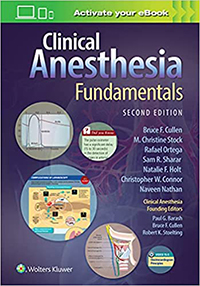
Edition 2 (2021)
Bruce Cullen, M. Christine Stock, Rafael Ortega, Sam Sharar, Natalie Holt, Christopher Connor, Naveen Nathan
Part of the popular and well-regarded Clinical Anesthesia family of titles, and founded by Drs. Paul G. Barash, Bruce F. Cullen, and Robert K. Stoelting, Clinical Anesthesia Fundamentals, Second Edition, is a concise, highly visual resource covering the core concepts in anesthesiology. The editorial board comprised of Drs. Bruce F. Cullen, M. Christine Stock, Rafael Ortega, Sam R. Sharar, Natalie F. Holt, Christopher W. Connor, and Naveen Nathan, and their team of expert contributors clearly and simply present the information you need on key aspects of anesthesia for every specialty area and key organ systems. From physiology and pharmacology to anatomy and system-based anesthesia, it uses full-color graphics, easy-to-read tables, and clear, concise text to convey the essential principles of the field.
Presents material in a highly visual manner, including “Did You Know” boxes that highlight key points, as well as video boxes that reference more than 120 short, to-the-point tutorial videos in the eBook, in addition to end of chapter multiple choice questions, answers, and explanations.
New features include: a chapter on anesthesia for the older patient as well as 31 chapter-based infographics that provide “At a Glance” or “A Closer Look” at topical content.
The ebook also comes with access to question-based interactive versions of the infographics, as well as dozens of video lectures covering every chapter in the book, including 500integrated review questions throughout.
Includes an introductory section covering scientific and technical foundations, pharmacology, and technology.
Features helpful appendices with handy formulas; an electrocardiography atlas; numerous key protocols, guidelines, and standards; algorithms, and more.
Ideal for medical students, residents, SRNAs, CRNAs, and practitioners studying for board exams—anyone who needs a quick overview of the essential elements of clinical anesthesia in an easily accessible format.
Edition 1 (2019)
Kai Matthes, Herodotus Ellinas
A new textbook of pediatric anesthesiology – modeled after the bestselling Morgan and Mikhail’s Clinical Anesthesiology
Filling a void in the anesthesiology literature, this new text delivers streamlined yet comprehensive discussion of the unique aspects and considerations necessary to successfully manage pediatric patients.
For each procedure covered, there is a review of equipment, technique, alternatives, and ways to manage complications or troubleshoot errors. A complete multi-media resource, LANGE Clinical Pediatric Anesthesiology includes a link to 50 videos depicting key pediatric anesthetic procedures. This unique resource is ideal for trainees and practitioners who have limited time and need a solution to a specific clinical problem. Sections include: Basic Science, Pharmacology, Anesthetic Practice, Procedures, and Special Considerations.
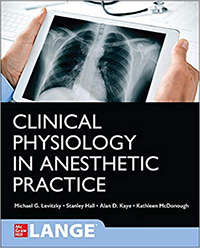
Edition 1 (2021)
Michael Levitzky
A clinically relevant, reader -friendly text covering everything the anesthesia provider must know about physiology
This well-illustrated new resource is the most concise and high-yield presentation of physiology topics available to the anesthesia provider. The authors (who are both educators and clinicians) deliver a complete overview of physiology, but, since this book is written for the anesthesia provider, the bulk of the text is dedicated to cardiovascular and respiratory physiology. Clinical Physiology in Anesthetic Practice distinguishes itself from general medical physiology books by the inclusion of case studies and clinical correlation boxed inserts that emphasize key fact that relate to real-world practice.
•Numerous case studies demonstrate the clinical relevance of basic science
•The author are experienced educators and clinicians, and know how to present difficult concepts in the most interesting and reader-friendly manner possible
•Key Points summarize must-know information, providing an excellent framework for board review
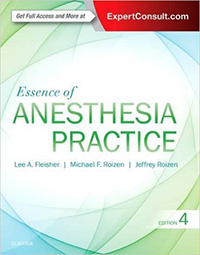
Edition 4 (2017)
Lee Fleisher, Michael Roizen, Jeffrey Roizen
Essence of Anesthesiology Practice makes it easy to formulate anesthesia plans through a consistent format and discussions of the problems, causes, comorbidities, and anesthesia implications for over 600 clinical topics. Drs. Fleisher and Roizen present a completely revised new edition that includes coverage of many new conditions, procedures, and drugs. Online access to the fully searchable text at www.expertconsult.com means that you can get the information you need more easily and conveniently.
Easily formulate anesthesia plans through a consistent format that covers a single clinical topic on each page, with a review of its problems, causes, comorbidities, and anesthesia implications.
Get state-of-art, reliable coverage from an international team of experts who discuss common and rare conditions and how to manage them.
Understand the interactions of common drugs and alternative medicine so that you can develop anesthesia plans accordingly.
Access the fully searchable text online at www.expertconsult.com.
Quickly reference key information using the carefully templated text that highlights the most important anesthetic considerations in a consistent, user-friendly layout.
Stay current on the latest anesthetic implications in regards to coexisting diseases, procedures, drugs, and alternative and complementary therapies, including coverage of mitochondrial myopathy, atrial fibrillation ablation, awake craniotomy, stereotactic neurosurgery, neuroprotection, dexmedetomidine, and other hot topics.
Master the core knowledge of Anesthesia and overcome new factors in anesthetic care of patients with trusted reference in a high yield format
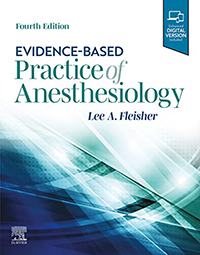
Edition 4 (2022)
Lee Fleisher
Addressing both routine and complex situations with practical decision-making tools, Evidence-Based Practice of Anesthesiology, 4th Edition, helps anesthesiologists make sound decisions in everyday practice. World-renowned authority, Dr. Lee A. Fleisher, takes an evidence-based approach to a variety of high-impact topics related to effective perioperative patient management: preoperative assessment; monitoring and administration of anesthesia during surgery; postoperative intensive care management; and postoperative pain management. The 4th Edition has been updated from cover to cover, helping you make informed clinical decisions based on reliable, up-to-date guidance in every aspect of patient care.
Explores important issues in perioperative management, discussing the available options, examining the relevant research, and presenting practical recommendations.
Features concise, to-the-point chapters with numerous quick-reference tables for fast and effective decision making.
Includes decision trees throughout to provide visual guidance and a logical flow of key decision points.
Contains nine new chapters on how to identify patients at risk for postoperative neurocognitive disorder; the best strategy for perioperative ACE and ARB agents; emergency laparotomy; optimal postoperative analgesia and the opiate naïve patient; the best method for perioperative handoffs; myocardial injury after non-cardiac surgery (MINS); and more.
Helps you master the current best practices you need to know for successful day-to-day practice and oral board review.
Enhanced eBook version included with purchase. Your enhanced eBook allows you to access all of the text, figures, and references from the book on a variety of devices.
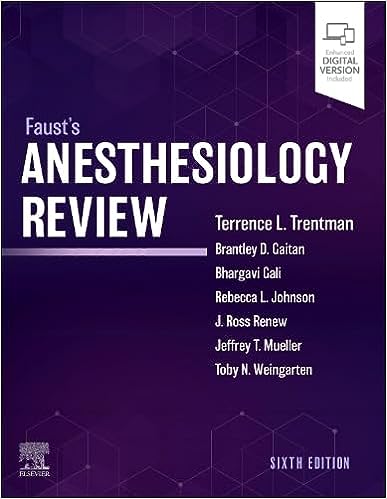
Edition 6 (2023)
Terrence Trentman, Brantley Gaitan, Bhargavi Gali, Rebecca Johnson, Jeff Mueller, Steven Rose, Toby Weingarten
Authored by current and former physicians at the Mayo Clinic, Faust's Anesthesiology Review, 6th Edition, is an invaluable review source for success on exams and in practice. It covers a broad range of important and timely topics in a succinct, easy-to-read format, providing the essential information you need to master the latest advances, procedures, guidelines, and protocols in anesthesiology.
Provides in-depth, yet succinct clinical synopses of all topic areas found on the ABA/ASA exam, with the perfect amount of information to ensure exam success.
Contains five new chapters: Principles of Preoperative Evaluation; Anesthesia for Patients who are Lactating; Peripheral Nerve Blocks of the Anterior Trunk; Sustainability in Anesthesiology and the Operating Room; and Anesthesia During a Pandemic.
Covers the core knowledge needed to succeed in today’s anesthesiology practice, including awake craniotomy, non-OR anesthesia (NORA), neuromodulation, using arterial pressure waveform to derive cardiac output, enhanced recovery (ERAS) pathways, chemical dependency in anesthesia personnel, lung transplantation, anesthesia for robotic surgery, and more.
Includes boxes, tables, charts, and graphs throughout to provide visual guidance and summarize critical information.
Features concise chapters for efficient review and effective recall, making this an ideal study tool for certification, recertification, or as a refresher for anesthesiology practice.
An eBook version is included with purchase. The eBook allows you to access all of the text, figures and references, with the ability to search, customize your content, make notes and highlights, and have content read aloud.
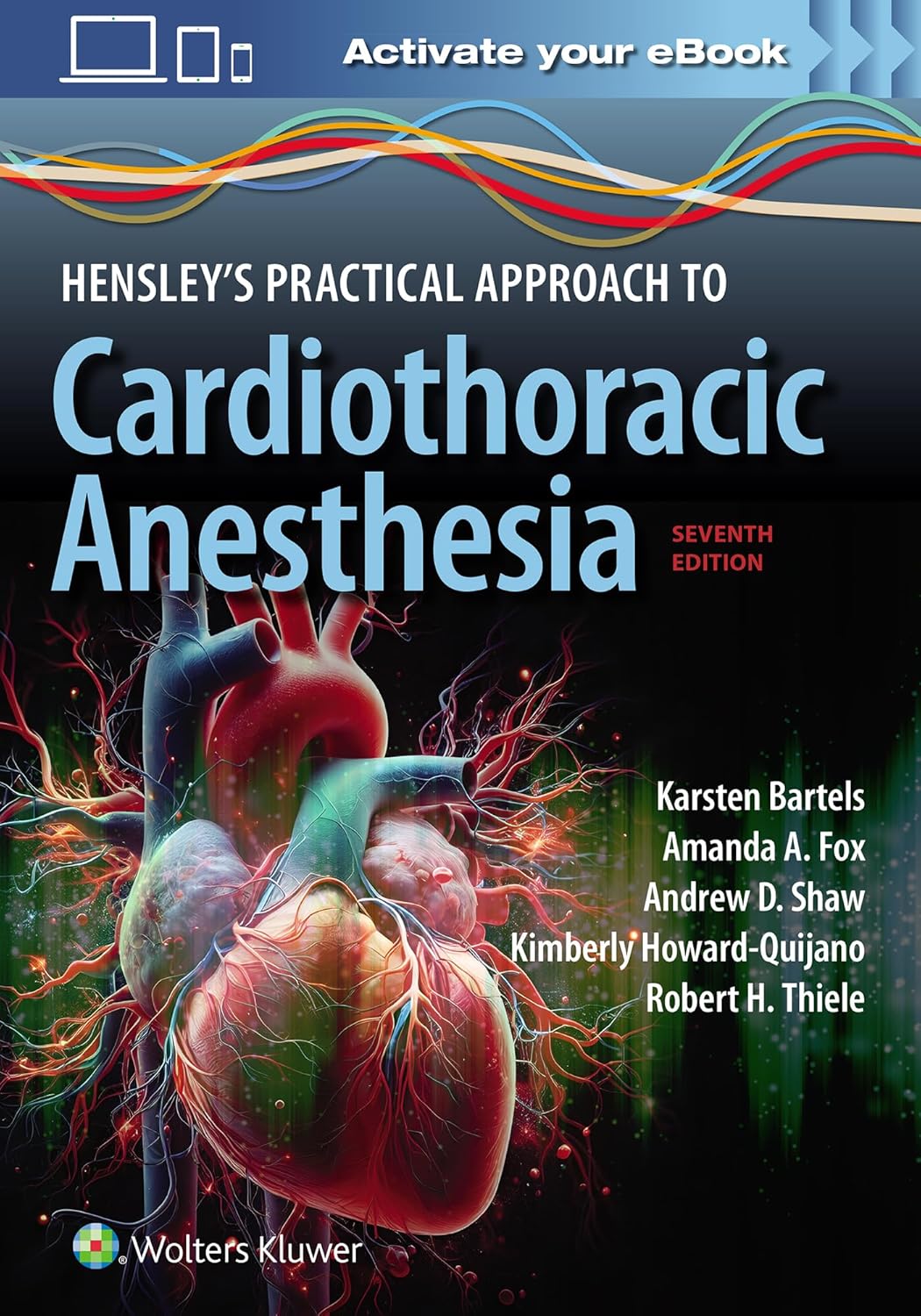
Edition 7 (2024)
Karsten Bartels, Amanda Fox, Andrew Shaw, Kimberly Howard-Quijano, Robert Thiele
Offering a comprehensive, up-to-date overview of the field, Hensley’s Practical Approach to Cardiothoracic Anesthesia, Seventh Edition, edited by Drs. Karsten Bartels, Amanda A. Fox, Andrew D. Shaw, Kimberly Howard-Quijano, and Robert H. Thiele, is an ideal reference and review tool for fellows, residents, and practicing anesthesiologists. Concisely written and readily accessible, it combines the depth of a reference book with the no-nonsense guidance of a clinically-oriented handbook. This edition has been newly reorganized for current practice patterns and to better align with the ACGME requirements for adult cardiothoracic anesthesiology.
• Presents information in a concise, bulleted format, making it easy to read and absorb key points
• Key points are identified at the beginning of each chapter and in the margins with clinical pearls appearing throughout the text
• Provides up-to-date coverage of cardiac physiology and pharmacology, pre-procedural patient preparation, anesthetic management of specific disorders and procedures, post-procedural management, and more
• Offers the experience and expertise of three new co-editors and nearly 70 contributors from over 35 institutions
• Over 30 echocardiography clips demonstrate assessment of valve disorders, arythmias and more.
• A valuable resource for anesthesia residents, fellows in cardiac anesthesia, anesthesiology practitioners, perfusionists, and CRNAs
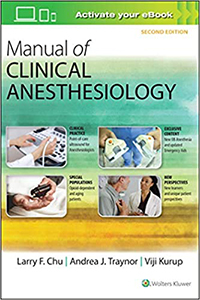
Edition 2 (2021)
Larry Chu, Andrea Traynor, Viji Kurup
Designed for rapid reference at the point of care, Manual of Clinical Anesthesiology is the clinician’s go-to resource for practical, clinically focused information on all aspects of anesthesia management. The comprehensive second edition consolidates multidisciplinary expertise in one resource, offering revised and updated content in a highly visual, portable format, with short, easy-to-read chapters, margin icons noting pearls and pitfalls, and more.
Presents information in a rapid-reference, outline format throughout, with color-coded sections, chapter summaries, pearls and pitfalls, cross-references to related text, and more.
Features new chapters on: Hemorrhage in Obstetrics, Highly Lethal Viruses (such as SARS and Ebola), Thromboelastogram/Point of Care Laboratory Interpretation, Hazards in the MRI Suite, and Substance Abuse in Medical Professionals, as well as new cognitive aids for Caudal Anesthesia, Cardiopulmonary Bypass, Ultrasound-Guided Neuraxial Anesthesia, OB Cardiac Arrest, Transthoracic Echo, and PALS.
Covers monitoring, equipment and procedures, anesthesia and comorbid diseases, pediatric anesthesia, subspecialty anesthesia, and other key topics.
Includes four full-color atlases that clearly depict procedures, transesophageal echocardiography, peripheral nerve blocks, and crisis management (including new crisis management checklists) as well as appendices of foreign language phrases and a drug dosing pull-out card.
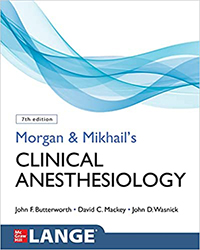
Edition 7 (2022)
John Butterworth, David Mackey, John Wasnick
he most engagingly written, clinically relevant overview of the practice of anesthesiology
Morgan & Mikhail’s Clinical Anesthesiology, Seventh Edition is an essential resource for all anesthesia students and practitioners. Hailed as the best primer on the topic, this trusted classic delivers comprehensive coverage of the field’s must-know basic science and clinical topics in a clear, easy-to-understand presentation. The text is also ideal for coursework, review, or as a clinical refresher.
Key features that make it easier to understand complex topics:
Rich full-color art work combined with a modern, user-friendly design make information easy to find and remember
The perfect distillation of essential information: succinct without sacrificing important details
Case discussions promote application of concepts in real-world clinical practice
Key Concepts at the beginning of each chapter identify important issues and facts
Numerous tables and figures encapsulate important information and facilitate recall
Up-to-date discussion of all relevant areas of anesthesiology, including equipment and monitors, pharmacology, pathophysiology, regional anesthesia, pain management, and critical care
URLs for societies, guidelines, and practice advisories
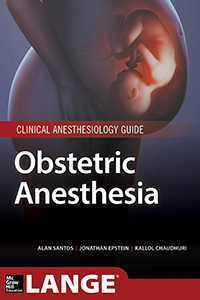
Edition 1 (2015)
Alan Santos, Jonathan Epstein, Kallol Chaudhuri
Understand the anesthetic management challenges of the obstetric patient with this complete primer and review
Obstetric Anesthesia is a clear, concise, and practical manual covering the basics of obstetric anesthesiology and the principles of basic management at the point of care. This essential introductory text covers the fundamental topics in an efficient and highly clinical manner. Numerous tables, bulleted lists, and text boxes highlight key issues such as common co-existing diseases and conditions that may affect anesthetic management.
Obstetric Anesthesia features thirty chapters grouped into six logical sections:
Pregnancy
Providing Anesthesia
Anesthetic Complications
Obstetric Complications
Common Co-Morbidities During Pregnancy
Trauma During Pregnancy
Enriched by contributions from practicing obstetrical anesthesiologists and renowned instructors, Obstetric Anesthesia includes the most up-to-date practice guidelines. It is a valuable clinical refresher and an outstanding board review.
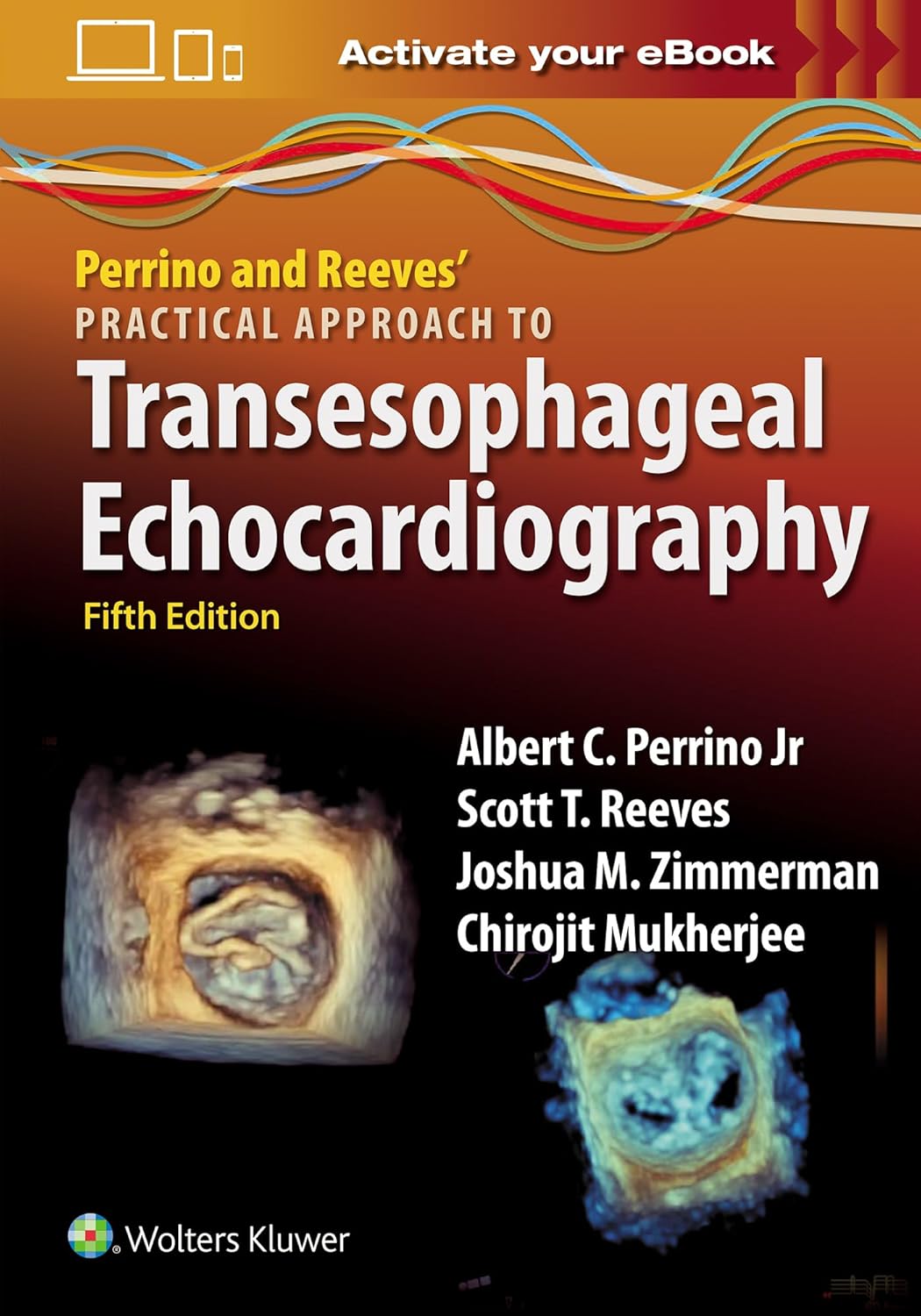
Edition 5 (2025)
Albert Perrino Jr., Chirojit Mukherjee, Joshua Zimmerman
Covering both the science behind transesophageal echocardiography (TEE) and its uses for monitoring and diagnosis, Perrino and Reeves’ Practical Approach to Transesophageal Echocardiography, Fifth Edition, provides the information you need for all levels of transesophageal echocardiography usage and testing. Expertly edited by Drs. Albert C. Perrino, Jr, Scott T. Reeves, Joshua M. Zimmerman and Chirojit Mukherjee, this concisely written manual features numerous figures and review questions in every chapter, allowing you to quickly digest and apply critical information in actual clinical settings.
Covers key topics such as 2D imaging, Doppler echo, valvular disease, and specific clinical challenges
Features more than 300 end of chapter multiple-choice review questionswith answers and rationales as well as over 400 clinical and procedural video clips.
Discusses common artifacts and pitfalls, as well as techniques and tricks for optimizing TEE images
Contains valuable appendices covering cardiac cross section criteria, cardiac dimensions, hemodynamic calculations, valve prostheses, and more
Shares the knowledge and expertise of two new editors: Joshua Zimmerman of the University of Utah School of Medicine and Chirojit Mukherjee of Helios Park Clinic in Germany
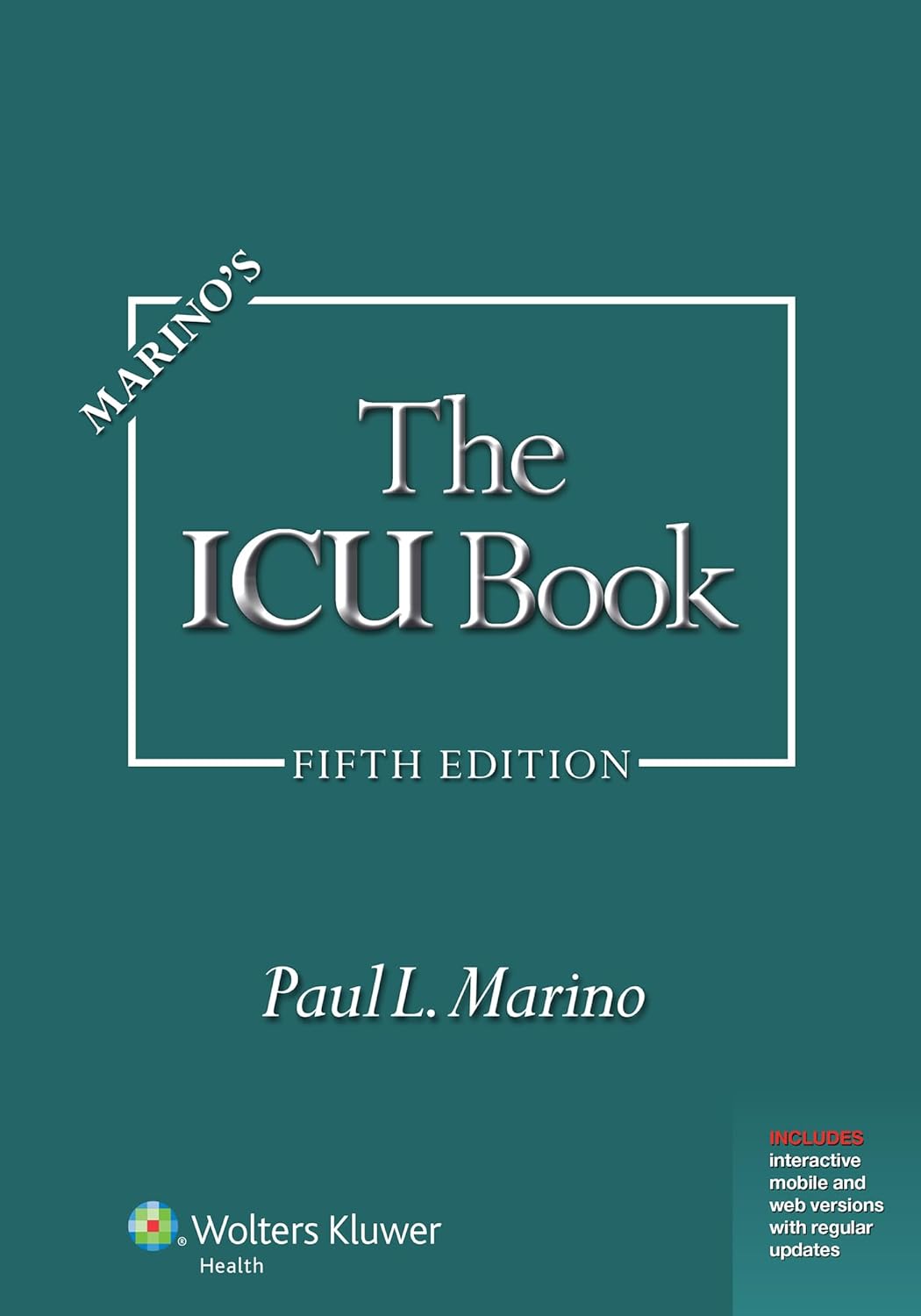
Edition 5 (2024)
Paul Marino
Dr. Paul L. Marino’s concise, engaging writing style is just one of many reasons that Marino’s The ICU Book is the best-selling reference in critical care. This highly regarded, full-color resource contains the essential information needed to care for patients in any ICU, regardless of the specialty designation of the unit. The newly revised Fifth Edition continues the focus on practical aspects of patient care and will appeal to anyone with an interest in the care of critically ill patients. The intended audience incudes medical students, interns and residents in medicine, surgery, and anesthesiology, critical care physicians and nurses, physician’s assistants, respiratory therapists, and paramedics.
Dr. Marino has been a practicing critical care specialist for 44 years, and the material in his book is a reflection of this vast experience.
The text has been completely rewritten and incorporates the latest concepts and most recent clinical practice guidelines.
Because this is a single-author text, the writing and style are consistent from chapter to chapter, and redundancies are held to a minimum.
New chapters have been added on fluid management, approaches to clinical shock, acute pulmonary embolism, liver failure, and acute pancreatitis.
As in prior editions, there are numerous illustrations and tables that highlight the material in the text, and each chapter ends with a section called “A Final Word” that presents a take-home message from the chapter.
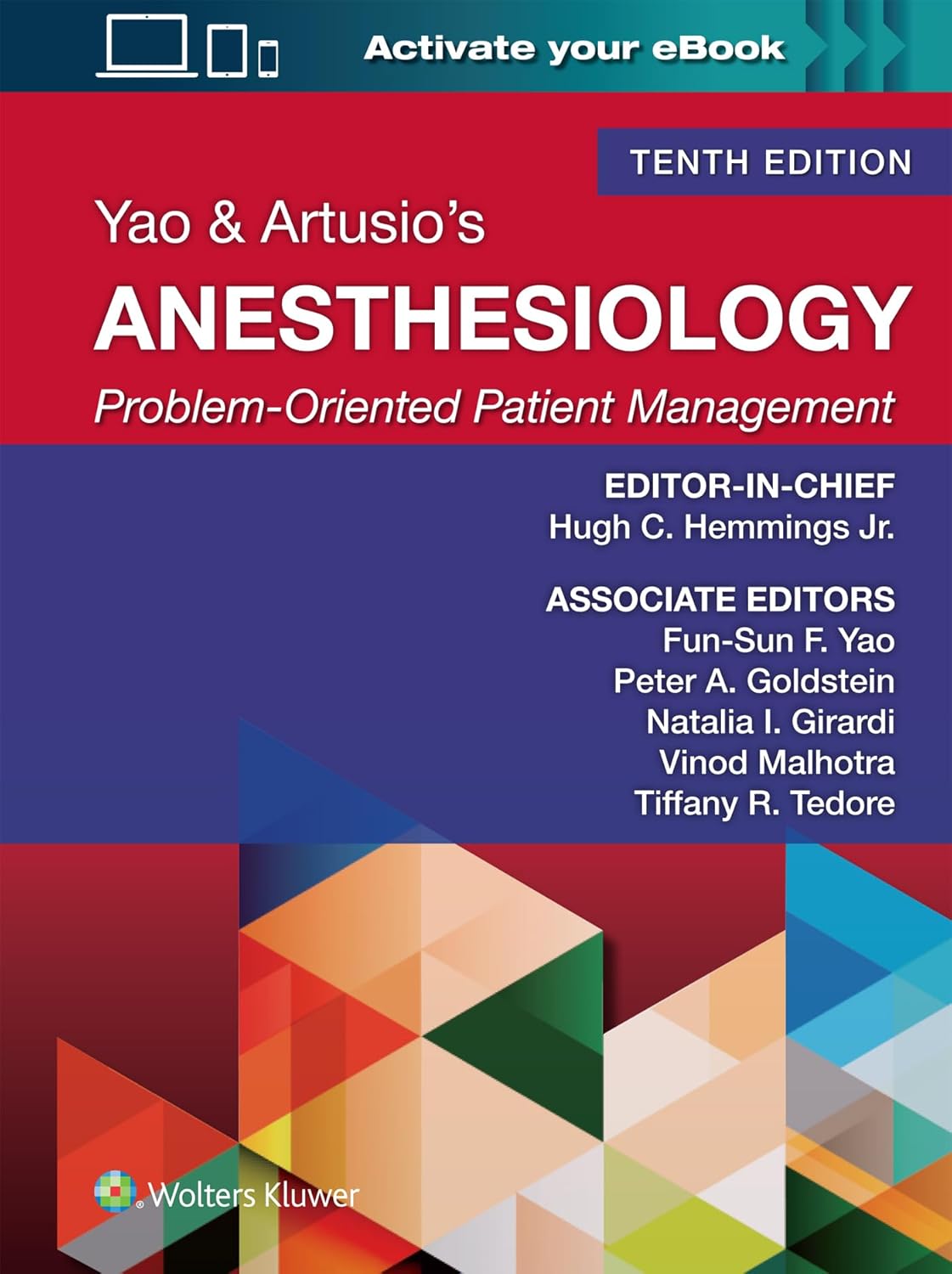
Edition 10 (2025)
Hugh Hemmings, Fun-Sun Yao, Peter Goldstein, Natalia Girardi, Vinod Malhotra, Tiffany Tedore
Prepare for the oral and written boards with this case-based, easy-to-use review tool from Drs. Hugh C. Hemmings Jr., Fun-Sun F. Yao, Peter A. Goldstein, Natalia I. Girardi, Vinod Malhotra, and Tiffany Tedore. Yao & Artusio’s Anesthesiology: Problem-Oriented Patient Management, Tenth Edition, contains more than 60 real-world cases accompanied by questions that conform to the four areas of questioning on the oral boards, reinforcing step-by-step critical thinking about today’s surgical anesthesia and patient management. This core text has been thoroughly revised to bring you up to date with all that’s new in the field.
Features a problem-based approach to emphasize critical thinking, collaborative decision making, and problem-solving skills
Uses a consistent chapter format that includes presentation of a case; questions on medical disease and differential diagnosis, preoperative planning and preparation, intraoperative management, and postoperative management; and complete answers and discussion of the case
Contains new and updated content throughout, including topics such as coagulopathy and major and complex spine surgery, as well as updated references for further study and clarification
Allows you to repeatedly work through key considerations that reinforce logical, critical thinking about patient management

